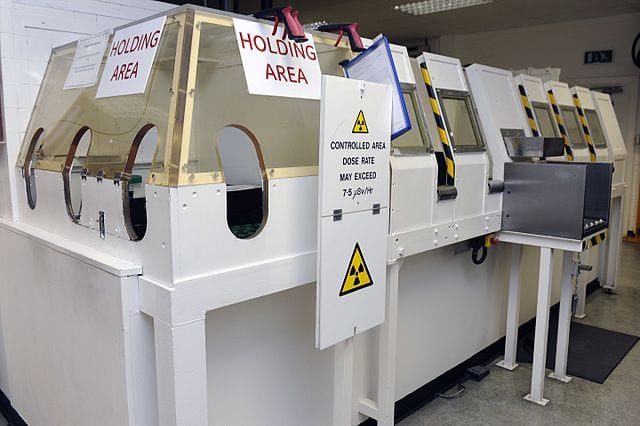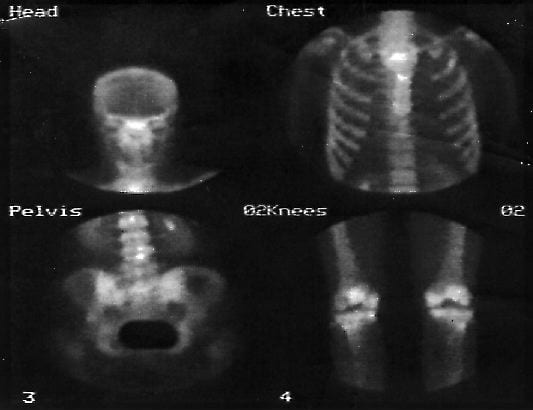Radiopharmaceuticals
Radiopharmaceuticals are radioactive compounds used for both diagnostic and therapeutic purposes. Radiopharmaceuticals generally mimic naturally occurring chemicals with specific biological functions. Tissues with unique properties, such as a high metabolic rate, accumulate the radionuclide at far higher rates than tissues without these properties. This feature allows for imaging and treatment based on biological activity.
Uses of Radiopharmaceuticals
Radiopharmaceuticals are classified as being for either therapeutic or diagnostic use.
Therapeutic Radiopharmaceuticals
Therapeutic radiopharmaceuticals are intended to deliver a sufficiently large dose of the radiopharmaceutical to the target tissue, while minimizing the dose to non-target tissues. This requirement limits the choice of available nuclides to those that decay via short range emissions, such as beta particles and alpha particles.
Key Point: All currently approved therapeutic radiopharmaceuticals are beta or alpha emitters whose short ranged radiation reduces dose to non-target tissue and the general public.
Diagnostic Radiopharmaceuticals
Diagnostic radiopharmaceuticals are used to determine the presence and position of biological processes or features. A good diagnostic radiopharmaceutical should have the following properties:
- Low radiation dose
- Radiation should be of a minimal dose while producing photons with a high enough energy to readily escape the patient’s body and be detected.
- High radiation detection efficiency
- Radiation escaping the patient should be of low enough energy that it is readily detectable.
- High specificity
- The radiopharmaceutical should readily accumulate in the tissue of interest and should not accumulate elsewhere.
- Safety
- The radiopharmaceutical should be chemically non-toxic and safe for patient administration.
- Cost effective
- The production of radiopharmaceuticals should be cost effective in clinically useful quantities.
Key point: Most nuclear imaging equipment, except for PET scanners, is optimized to collect photons of about 140 keV. This is because 140 keV has been found to be a good trade-off between minimizing patient dose and a high radiation detection efficiency. Lower energy photons would increase the radiation dose to the patient due to attenuation within the body, while higher energy photons are more difficult to detect.
Radiopharmaceutical Mechanisms of Localization
The utility of a radiopharmaceutical is driven by its ability to selectively accumulate within desired tissues. Therefore, significant attention is paid to the biochemical mechanisms which fulfill this role. Below are some common methods of localization.
Active Transport
Active transport involves the use of biological mechanisms that selectively uptake the radiopharmaceutical into a cell against a concentration gradient. That is, active transport requires cellular components which transport the drug from areas of low concentration to areas of high concentration.
Common Examples
I-123 is commonly used to assess the structure and function of the thyroid gland. Iodine is actively transported into the thyroid gland, where a process termed the organification of iodine allows for the incorporation of iodine into thyroid hormones.
F-18 FDG is a glucose analog that concentrates in highly active cells using glucose for energy. F-18 FDG is useful for imaging active areas of cancer growth. The FDG is actively transported across the cell membrane, along with glucose, to fuel the cell’s elevated activity levels.
Key Point: Active transport, the mechanism by which F-18 FDG functions, can be thought of as reverse osmosis by which concentrations are increased on one side of a barrier (cell wall) rather than equalized.
Compartment Localization
Compartment localization generally involves placing a radiopharmaceutical into a specific anatomic compartment and imaging for signs of leakage.
Common Examples
Xe-133 gas which is inhaled into the lungs.
Tc-99m labeled red blood cells which are introduced into the circulatory system.
Receptor Binding
Receptor binding radiopharmaceuticals adhere to specific binding sites located on cells of interest. Receptor binding holds promise in targeting specific abnormal cell types based on their receptors.
Common Examples
In-11-octreotide is used for the localization of neuroendocrine tumors because of its ability to bind to somatostatin receptor sites.
Physiochemical Absorption
Physiochemical absorption involves the incorporation of radiopharmaceuticals into the structure of a target cell.
Common Examples
Ra-223, in the form of Ra-223 dichloride, mimics the properties of calcium allowing it to be incorporated into the mineral structure of bone. Ra-223 is an alpha emitter and is used for the treatment of prostate cancer which has invaded boney anatomy.
Navigation
Not a Premium Member?
Sign up today to get access to hundreds of ABR style practice questions.



